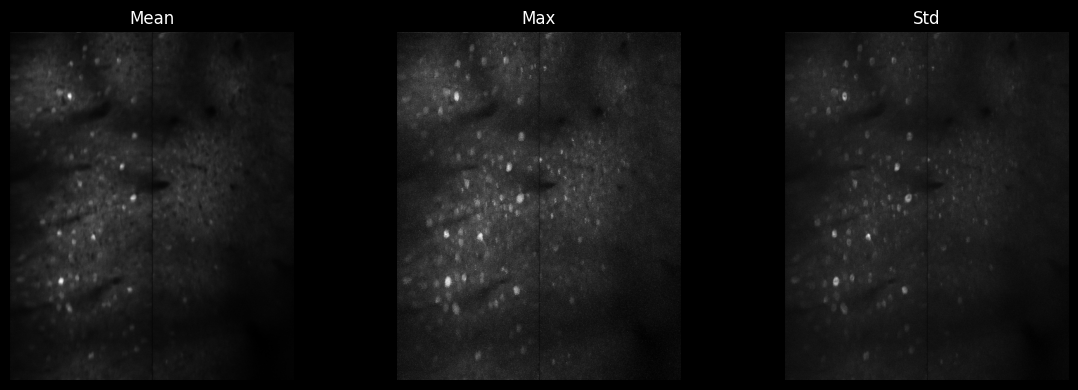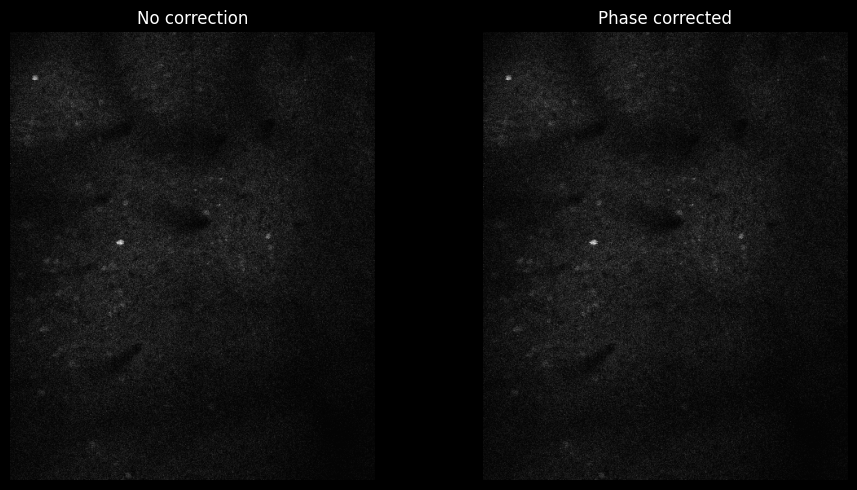mbo_utilities: User Guide#
Installation | Array Types | MBO Hub
An image I/O library with an intuitive GUI for scientific imaging data.
Reading and Writing Data#
# Read any supported format - returns a lazy array
arr = mbo.imread(
inputs, # Path, list of paths, glob pattern, or numpy array
**kwargs # Format-specific options passed to underlying reader
)
# Write to any supported format
mbo.imwrite(
lazy_array, # Source array to write
outpath, # Output directory or file path
ext='.tiff', # Output format: '.tiff', '.zarr', '.h5', '.bin', '.npy'
planes=None, # List of plane indices to extract (e.g. [1, 2, 3], or None = all)
num_frames=None, # Number of frames to write (None = all)
register_z=False, # Enable Suite3D axial registration
roi=None, # ROI selection for MboRawArray, None = stitched horizontally
metadata=None, # Add metadata to this file
overwrite=False, # Overwrite existing files
order=None, # Order of z-planes to reorder (e.g. [1, 3, 4, 5, 2, 6])
target_chunk_mb=100, # Target chunk size for zarr/h5
output_name=None, # WIP: Custom output filename
**kwargs # Format-specific options
)
Input |
Array Type |
|---|---|
|
|
|
|
|
|
|
|
|
|
Raw ScanImage |
|
|
|
from pathlib import Path
import numpy as np
import mbo_utilities as mbo
import matplotlib.pyplot as plt
RAW_PATH = Path(r"D:/demo/raw")
SAVE_PATH = Path(r"D:/demo/planes")
The Kernel crashed while executing code in the current cell or a previous cell.
Please review the code in the cell(s) to identify a possible cause of the failure.
Click <a href='https://aka.ms/vscodeJupyterKernelCrash'>here</a> for more info.
View Jupyter <a href='command:jupyter.viewOutput'>log</a> for further details.
Load a data file#
This demo will use raw ScanImage tiffs.
Raw ScanImage TIFFs are detected automatically and return an MboRawArray:
arr = mbo.imread(RAW_PATH)
print(f"Type: {type(arr).__name__}")
print(f"Shape (T, Z, Y, X): {arr.shape}")
print(f"Planes: {arr.num_planes}, Frames: {arr.num_frames}, ROIs: {arr.num_rois}")
Type: MboRawArray
Shape (T, Z, Y, X): (1574, 14, 550, 448)
Planes: 14, Frames: 1574, ROIs: 2
Save a small test dataset#
Extract 100 frames from plane 7 to work with:
# arr.fix_phase = True # Enable scan-phase correction
# arr.roi = None # Stitch ROIs together
mbo.imwrite(
arr,
SAVE_PATH,
ext=".zarr",
planes=[7, 8, 9],
num_frames=100,
overwrite=True,
roi=None # 0 to separate, None to stitch ROIs
)
print(f"Saved to: {SAVE_PATH}")
Saved to: D:\demo\planes
Read and explore the saved data#
# read a single plane
arr = mbo.imread(SAVE_PATH)
print(f"Volume Shape: {arr.shape}, Dtype: {arr.dtype}")
arr = mbo.imread(SAVE_PATH / "plane07_stitched.zarr")
print(f"Plane Shape: {arr.shape}, Dtype: {arr.dtype}")
Volume Shape: (100, 3, 550, 448), Dtype: int16
Plane Shape: (100, 1, 550, 448), Dtype: int16
# Numpy-like indexing
frame = arr[0] # First frame
subset = arr[10:20] # Frames 10-19
crop = arr[:100, 0, 100:200, 100:200] # Spatial crop
print(f"Single frame: {frame.shape}")
print(f"Subset: {subset.shape}")
print(f"Crop: {crop.shape}")
Single frame: (550, 1, 448)
Subset: (10, 1, 550, 448)
Crop: (100, 100, 100)
# Reduction operations
mean_img = arr[:200, 0, :, :].mean(axis=0).squeeze()
max_img = arr[:200, 0, :, :].max(axis=0).squeeze()
std_img = arr[:200, 0, :, :].std(axis=0).squeeze()
fig, axes = plt.subplots(1, 3, figsize=(12, 4))
axes[0].imshow(mean_img, cmap='gray'); axes[0].set_title('Mean')
axes[1].imshow(max_img, cmap='gray'); axes[1].set_title('Max')
axes[2].imshow(std_img, cmap='gray'); axes[2].set_title('Std')
for ax in axes: ax.axis('off')
plt.tight_layout()
plt.show()

Accessing metadata#
mbo.imread automatically collects all available metadata in the file.
All lazy-arrays have metadata available as a property:
metadata = lazy_array.metadata
print(metadata["num_frames"])
>>> 1500
This metadata reflects information on all the options selected and otherwise available in ScanImage, for an image acquisition, as well as specific parameters that pertain to the current parameter set e.g. number of rois, number of frames, scan-phase correction properties, etc.
There is a lot of ScanImage metadata, even after cleaning empty values.
To view metadata, it’s helpful to use pprint so that the scanimage metadata doesn’t flood the terminal.
You can quickly view metadata via the GUI Widgets:
uv run mbo D:/demo/raw --metadata
Or via info:
uv run mbo info D:/demo/raw
from pprint import pprint
pprint(arr.metadata, depth=1)
{'PhysicalSizeX': 2.0,
'PhysicalSizeXUnit': 'micrometer',
'PhysicalSizeY': 2.0,
'PhysicalSizeYUnit': 'micrometer',
'PhysicalSizeZ': 5.0,
'PhysicalSizeZUnit': 'micrometer',
'border': 3,
'dtype': 'int16',
'dx': 2.0,
'dy': 2.0,
'dz': 5.0,
'file_paths': [...],
'fix_phase': True,
'fov': [...],
'fov_px': [...],
'frame_rate': 13.99553782981917,
'frames_per_file': [...],
'max_offset': 4,
'mean_subtraction': False,
'ndim': 2,
'nframes': 1574,
'num_files': 2,
'num_fly_to_lines': 16,
'num_frames': 1574,
'num_planes': 14,
'num_rois': 2,
'objective_resolution': 61,
'offset': np.float64(1.0),
'page_height': 1116,
'page_width': 224,
'phasecorr_method': 'mean',
'pixel_resolution': (...),
'roi_groups': [...],
'roi_heights': [...],
'si': {...},
'size': 249984,
'umPerPixX': 2.0,
'umPerPixY': 2.0,
'umPerPixZ': 5.0,
'uniform_sampling': 1,
'upsample': 5,
'use_fft': False,
'voxel_size': (...),
'z_step': 5.0,
'zoom_factor': 2}
Saving data: Formats and Conversions#
Convert between any supported formats with imwrite().
Here, we load the .zarr previously saved, add some metadata, and re-save to several of the supported formats.
Note: Keep different filetypes in separate directories.
# Load the zarr we saved earlier
arr = mbo.imread(SAVE_PATH / "plane07_stitched.zarr")
new_metadata = {"test": [123]}
# Convert to different formats (each in its own directory)
mbo.imwrite(arr, SAVE_PATH / "tiff", ext=".tiff", overwrite=True, metadata=new_metadata)
mbo.imwrite(arr, SAVE_PATH / "hdf5", ext=".h5", overwrite=True, metadata=new_metadata)
mbo.imwrite(arr, SAVE_PATH / "suite2p", ext=".bin", overwrite=True, metadata=new_metadata)
print(f"New metadata: {mbo.imread(SAVE_PATH / "tiff").metadata["test"]}")
New metadata: [123]
Working with In-Memory Numpy Arrays#
You can wrap any numpy array with imread() to get full imwrite() support, including zarr chunking, compression, and sharding.
For detailed documentation on NumpyArray properties, methods, and use cases, see Array Types.
import numpy as np
import mbo_utilities as mbo
data = np.random.randn(100, 512, 512).astype(np.float32)
# Wrap with imread - returns a NumpyArray lazy array
arr = mbo.imread(data)
print(arr) # NumpyArray(shape=(100, 512, 512), dtype=float32, dims='TYX' (in-memory))
# Now you can use imwrite with all features
mbo.imwrite(arr, "output", ext=".zarr") # Zarr with chunking/sharding
mbo.imwrite(arr, "output", ext=".tiff") # BigTIFF
mbo.imwrite(arr, "output", ext=".bin") # Suite2p binary format
mbo.imwrite(arr, "output", ext=".h5") # HDF5
# 4D arrays (T, Z, Y, X) also work
volume = np.random.randn(100, 15, 512, 512).astype(np.float32)
arr4d = mbo.imread(volume)
print(f"dims: {arr4d.dims}, num_planes: {arr4d.num_planes}") # dims: TZYX, num_planes: 15
# Write specific planes (1-based indexing)
mbo.imwrite(arr4d, "output", ext=".zarr", planes=[1, 7, 14])
User Interface: MBO-GUI#
The mbo_utilities GUI can be opened in Jupyter Lab (NOT VSCode):
mbo.run_gui(arr)
You can also run mbo_utilities commands with your ennvironment activated, or with uv:
uv run mbo D:/demo/planes/plane07_stitched.zarr
# To run from the command line, through jupyter:
!uv run mbo --help
Usage: mbo [OPTIONS] COMMAND [ARGS]...
MBO Utilities CLI - data preview and processing tools.
GUI Mode:
mbo Open file selection dialog
mbo /path/to/data Open specific file in GUI
mbo /path/to/data --metadata Show only metadata
Commands:
mbo convert INPUT OUTPUT Convert between formats
mbo info INPUT Show array information (CLI)
mbo formats List supported formats
Utilities:
mbo --download-file URL -o /path/ Download file from GitHub
mbo --download-notebook Download user guide notebook
mbo --check-install Verify installation
Options:
--download-notebook Download the user guide notebook and exit.
--notebook-url TEXT URL of notebook to download.
--download-file TEXT Download a file from URL (e.g. GitHub).
-o, --output TEXT Output path for --download-file or --download-
notebook.
--check-install Verify the installation of mbo_utilities and
dependencies.
--help Show this message and exit.
Commands:
convert Convert imaging data between formats.
formats List supported file formats.
info Show information about an imaging dataset.
view Open imaging data in the GUI viewer.
!uv run mbo info D:/demo/raw
Loading: D:/demo/raw
Array Information:
Type: MboRawArray
Shape: (1574, 14, 550, 448)
Dtype: int16
Ndim: 4
Files: 2
- D:\demo\raw\demo_mk355_7_27_2025_00001.tif
- D:\demo\raw\demo_mk355_7_27_2025_00002.tif
Metadata:
nframes: 1574
num_frames: 1574
num_rois: 2
... and 42 more keys
Counting frames: 0%| | 0/2 [00:00<?, ?it/s]
Counting frames: 100%|██████████| 2/2 [00:00<?, ?it/s]
Special array characteristics#
Lazy arrays have special characteristics depending on what the filetype is used for.
Bi-directional Scan-phase correction (ScanImage Tiff)#
ScanImage Tiffs (MboRawArray) only.
Bidirectional scanning creates phase offsets between alternating lines:

arr.roi = None
fig, axes = plt.subplots(1, 3, figsize=(15, 5))
arr.fix_phase = False
img_no_corr = arr[:,7,:,:].max(axis=0)[130:190, 250:280]
axes[0].imshow(img_no_corr, cmap='gray')
axes[0].set_title('No Scan-Phase Correction', fontsize=12, fontweight='bold')
axes[0].axis('off')
arr.fix_phase = True
arr.use_fft = False
img_corr = scan[:,7,:,:].max(axis=0)[130:190, 250:280]
axes[1].imshow(img_corr, cmap='gray')
axes[1].set_title('With Scan-Phase Correction', fontsize=12, fontweight='bold')
axes[1].axis('off')
scan.fix_phase = True
scan.use_fft = True
img_fft = scan[:,7,:,:].max(axis=0)[130:190, 250:280]
axes[2].imshow(img_fft, cmap='gray')
axes[2].set_title('FFT Scan-Phase Correction\n(Best, Slower)', fontsize=12, fontweight='bold')
axes[2].axis('off')
plt.tight_layout()
plt.show()
# clear out these large arrays in memory
del img_no_corr, img_corr, img_fft

Multi-ROI handling (ScanImage Tiff)#
Control how multiple ROIs are handled.
By default, they are stitched horizontally:

arr = mbo.imread(RAW_PATH)
print(f"ROIs: {arr.num_rois}")
# roi=None: Stitch horizontally (default)
arr.roi = None
print(f"Stitched shape: {arr[0, 7].shape}")
# roi=0: Split into separate arrays
arr.roi = 0
roi1, roi2 = arr[0, 7]
print(f"Split shapes: {roi1.shape}, {roi2.shape}")
# roi=N: Select specific ROI (1-indexed)
arr.roi = 1
print(f"ROI 1 only: {arr[0, 7].shape}")
ROIs: 2
Stitched shape: (550, 448)
Split shapes: (550, 224), (550, 224)
ROI 1 only: (550, 224)
Axial registration (ScanImage Tiff: Suite3D)#
Light-beads-microscopy acquisition typically results in each z-plane having a spatial shift relative to adjacent planes. This can be corrected automatically by setting register_z=True.
Suite3D creates a s3d-preprocessed directory containing planar shifts and intermediates. During writing, these shifts are loaded and applied to selected z-planes.
arr = mbo.imread(RAW_PATH)
arr.roi = None
arr.fix_phase = True
mbo.imwrite(
arr,
SAVE_PATH / "zreg",
ext='.zarr',
num_frames=100,
planes=[6, 7, 8],
overwrite=True,
register_z=True, # Enable Suite3D axial registration
)
# Check outputs
print("Output directories:")
for p in (SAVE_PATH / "zreg").iterdir():
print(f" {p.name}")
# Load Suite3D registration summary
summary_path = SAVE_PATH / "zreg" / "s3d-preprocessed" / "summary" / "summary.npy"
if summary_path.exists():
summary = np.load(summary_path, allow_pickle=True).item()
plane_shifts = summary['plane_shifts']
print(f"Plane shifts (Y, X):\n{plane_shifts}")
# Visualize before/after registration
fig, axes = plt.subplots(1, 2, figsize=(10, 5))
axes[0].imshow(summary['raw_img'].max(axis=0), cmap='gray')
axes[0].set_title('Before registration (max proj)')
axes[1].imshow(summary['ref_img_3d'].max(axis=0), cmap='gray')
axes[1].set_title('After registration (max proj)')
for ax in axes: ax.axis('off')
plt.tight_layout()
plt.show()
Visualizations#
# Load Suite2p volume directory
# Any lazy array works here
from mbo_utilities import imread
import napari
arr = imread(r"D:\example_extraction\suite2p")
# Get pixel resolution from metadata (um/px)
pixel_resolution = arr.metadata.get("pixel_resolution", 1.0) # XY resolution
z_resolution = 15.0 # um/px in Z (adjust for your data)
# Scale: (Z, Y, X) in um/px
scale = (1, 16, 2, 2)
viewer = napari.Viewer(ndisplay=3)
viewer.add_image(
arr,
name="Volume",
scale=scale,
interpolation3d="cubic",
)
viewer.show(block=True)
Inconsistent frame counts across planes: [1574, 1500, 1574, 1574, 1574, 1500, 1500, 1574, 1574, 1574, 1574, 1574, 1574, 1574]. Using minimum: 1500
Fastplotlib (Jupyter/Command line only)#
Interactive pixel trace visualization with fastplotlib:
import fastplotlib as fpl
from ipywidgets import VBox
arr = mbo.imread(SAVE_PATH / "plane07_stitched.zarr")
iw_movie = fpl.ImageWidget(arr[:], cmap="viridis")
tfig = fpl.Figure()
raw_trace = tfig[0, 0].add_line(np.zeros(arr.shape[0]))
@iw_movie.managed_graphics[0].add_event_handler("click")
def pixel_clicked(ev):
col, row = ev.pick_info["index"]
raw_trace.data[:, 1] = iw_movie.data[0][:, row, col]
tfig[0, 0].auto_scale(maintain_aspect=False)
VBox([iw_movie.show(), tfig.show()])
What’s next#
LBM-Suite2p-Python - ROI detection and signal extraction
